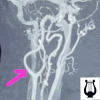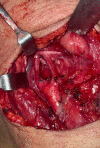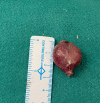Pseudo-Lyre Sign
- PMID: 37636664
- PMCID: PMC10447654
- DOI: 10.1007/s12070-023-03614-7
Pseudo-Lyre Sign
Abstract
To study the causes of the Pseudo- Lyre sign which is radiologically demonstrated in tumours other than the carotid body tumour. The study is based on an unusual case of neurofibroma of the cervical sympathetic chain presenting as a pulsatile mass in the carotid triangle in a 34 years female. Radiological investigation pointed to a diagnosis of a carotid body tumour because of typical splaying of the internal and external arteries causing the Lyre sign. At surgery, the tumour which was arising from the cervical sympathetic chain (CSC) was excised with minimum blood loss and histopathology confirmed it to be neurofibroma. This, we presume is the first ever report of a neurofibroma of the cervical sympathetic chain causing Lyre sign which we have referred to as Pseudo-Lyre sign. The various investigations which help in diagnosing the cause of Pseudo-Lyre sign have been discussed. All tumours causing Lyre sign on radio-imaging are not carotid body tumours. Other masses mostly neurogenic can demonstrate this sign and an attempt should be made preoperatively to confirm the diagnosis.
Keywords: Cervical sympathetic chain; Horner's syndrome; Lyre sign; Neurofibroma.
© Association of Otolaryngologists of India 2023. Springer Nature or its licensor (e.g. a society or other partner) holds exclusive rights to this article under a publishing agreement with the author(s) or other rightsholder(s); author self-archiving of the accepted manuscript version of this article is solely governed by the terms of such publishing agreement and applicable law.
Conflict of interest statement
Conflict of interestNone.
Figures





References
-
- Wang CP, Hsiao JK, KO JY. Splaying of the carotid bifurcation caused by a cervical sympathetic chain schwannoma. Ann Otol Rhinol Laryngo. 2004;1:113. - PubMed
LinkOut - more resources
Full Text Sources
